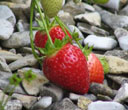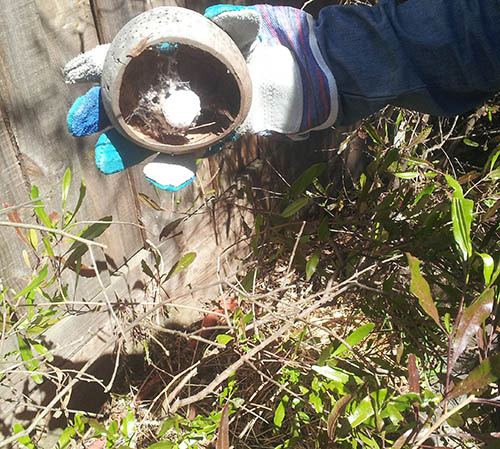good old fashioned fun for kids
Letting your kids help you to potter around in the garden, or search for local bugs and wildlife is a great way to teach them about the environment and how to care for it. Playing a simple environmental game or activity can involve planting, mulching, recycling, water saving or perhaps learning about local wildlife.
My kids are always finding little lizards, beetles and bugs which initiates plenty of conversations about what they eat, and how they live.
Meeting a spider and her nest of babies in our backyard (note the gloves!!) The mother spider is hidden behind the nest of babies – you can see one of her legs on the right.
**TIP- Setting aside a small corner of the garden especially for your kids gives them something of their own to nurture. You can help them to choose appropriate plant varieties that are fast-growing and easy to care for.
Garden gnomes and fairies
Let your kids be your special garden gnomes, helping you in the garden. Start by giving them simple tasks- as you weed or mow they can pick up the excess with a kiddy wheelbarrow. They will have great fun wheeling it around.
If you are planting they can help to dig the holes and place the seeds or seedlings in. You can even give them their own corner of the garden or a few pots for their own plants. It is good practice for having pets. If they can nurture a plant, understand that it needs care and attention on a daily basis then they have a good footing for caring for an animal. Ofcourse watering the plants is all important. Kids always love playing with water, and this gives them a purpose.
|
My daughter was given a little gardening set containing seeds, gloves and a little trowel, a super gift which gets plenty of use. The only problem I have is finding space in the garden for all her planting projects! Good plants for children include.. |
 |
- Nasturtiums– fast growing with edible bright flowers
- Strawberries– in the ground or in tiered pots if you have restricted space
- Lettuce– need plenty of water, can pick leaves almost every day
- Bean varieties– usually prolific producers-yummy to eat straight off the vine! (See Beans in Jar below)
- Herbs– very hardy, good for learning about smells
The very best thing about growing vegetables at home is the superb taste and the knowledge that they are free from harmful sprays. My daughter eats so many of our strawberries that very few of them actually make it onto our plates!
Make Your Own lavender sachets
If you have a lavender bush in your garden then you can put it to use.
You’ll need– lavender flowers, muslin or other thin cloth, ribbon.
Get you kids to pick the flower heads that are nearly all open and then dry them in the sun for a few days. Once dry, strip the flowers off by running your fingers along the stem. Cut the material into circles and drop a couple of spoonfuls of lavender into the middle of each circle. Help the children to tie the ribbon, preferably lavender in colour. These sachets can be hung in wardrobes and placed into drawers to keep clothes fresh and insect free.
Being a little bug-phobic, now that my daughter has discovered that lavender repels mosquitoes, she actually rubs it onto her skin! If nothing else it keeps her smelling nice!
**TIP– Lavender sachets under your pillow are said to give a good night’s rest and sweet dreams.
sunflowers
|
Kids love bright flowers and by growing sunflowers they can see how big these can grow. If you don’t have a sunny spot in your garden these can be grown in large pots. Once the plants reach about 15inches (1/2 meter) tall you can stake them. The seeds can be saved out of the flowers and used again next year! |
 |
Beans in a jar
This is an activity that I remember doing as a child. It is simple to set up but requires a little bit of patience on the part of your child. As soon as the beans start sprouting you will be able to see new growth each passing day.
Equipment– Glass jar, cotton thread, dried beans, blotting paper, adhesive tape, rubber band.
Soak the beans overnight and then tie a length of cotton to each bean- larger beans are easier to use but you can use peas if you have nimble fingers. To prepare the jar you need to roll up the blotting paer so that it is about layers thick and cut it (height wise) so that it fits neatly into the jar.
Using adhesive tape around the rim, hang your beans on the inside of the jar so that they hang about halfway down and touch the blotting paper as well as the side of the jar. Once the beans and blotting paper are in place you can use the elastic band to make sure the threads stay in position.
Add some water to your jar, not enough to submerge the beans but so that there is some left in the bottom of the jar after the blotting paper has soaked it up. Ensure that there is always some water in the bottom of the jar and that the beans stay in contact with the blotting paper.
Keep your jar in a position where it gets plenty of light. Once your beans have sprouted your kids can watch the roots and shoots developing. Your seedlings can be transplanted into the garden to produce their own crop of beans in a few weeks!
grow an avocado plant
If you eat avocados then this is a great use for the seed. After eating the fruit wash the seed and remove the brown covering from it. Poke a few toothpicks into it and suspend the seed over a glass full of water with the bottom half of the seed being immersed in the water.
Place it on a windowsill and the kids can top up the water and check it to see when the seed starts sprouting roots and then shoots from the top of the seed.
It can now be planted into a pot and will form into a nice bushy pot plant.

